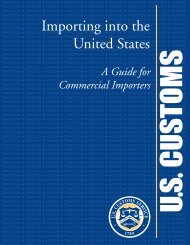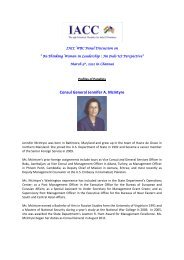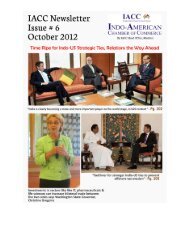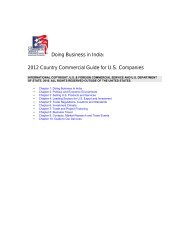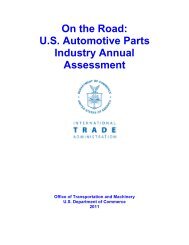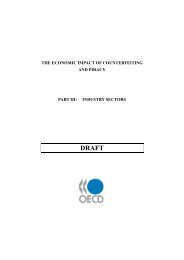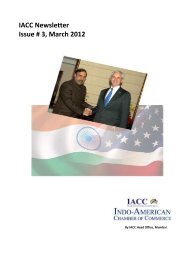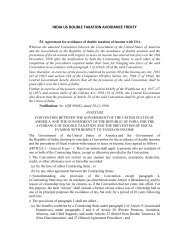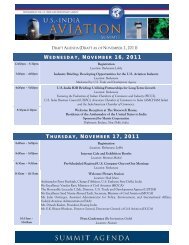Download the PDF version here - Indo-American Chamber Of ...
Download the PDF version here - Indo-American Chamber Of ...
Download the PDF version here - Indo-American Chamber Of ...
You also want an ePaper? Increase the reach of your titles
YUMPU automatically turns print PDFs into web optimized ePapers that Google loves.
in o<strong>the</strong>r parts of <strong>the</strong> world, and it will happen in India over <strong>the</strong> next few years. I have <strong>the</strong> broader plan in<br />
place.<br />
What are <strong>the</strong> challenges you might face?<br />
The challenge in India is not that we will not have demand for <strong>the</strong>se products. It is just that <strong>the</strong> timing<br />
and <strong>the</strong> pace of change needs to be understood and business evolution needs to be brought in sync with<br />
it. Because it can be painful if you invest ahead of <strong>the</strong> curve, just as it can be if you are left behind of <strong>the</strong><br />
curve.<br />
It is not easy building food brands in India for <strong>the</strong> simple reason that we are a very fragmented market.<br />
T<strong>here</strong> are tastes and preferences which vary across geographies. The retail networks are so fragmented<br />
that accessing it and creating <strong>the</strong> supply chain for it is extremely expensive and complex. And, obviously,<br />
<strong>the</strong>se are businesses that have a very low margin; so <strong>the</strong> cost of building a brand can be phenomenal for<br />
a category like flour. The food sector typically takes about 8-10 years of work in <strong>the</strong> market to get<br />
established. We have already gone through that phase. Going forward, a lot of it would be leveraging on<br />
what we have already created.<br />
What will be <strong>the</strong> mode of your expansion?<br />
It will be a combination of various strategies. Looking at <strong>the</strong> past, it has been a combination of investing<br />
in assets; it’s been about acquisitions and also acquiring brands. Our experience so far tells us that it has<br />
to be a mix of <strong>the</strong>se various things.<br />
What kind of reforms would you like to see in <strong>the</strong> commodities markets?<br />
Regulation is linked to maturity of <strong>the</strong> markets. These regulations are about protecting <strong>the</strong> farmer or<br />
consumer. To unshackle this, <strong>the</strong>re has to be a lot of trust-building. This is something that needs to<br />
come into <strong>the</strong> regulatory system but I think <strong>the</strong> trade also has responsibilities that of building trust with<br />
<strong>the</strong> government and with <strong>the</strong> consumer.<br />
We have APMC Act (Agricultural Produce Marketing (Regulation) Act), which restricts access to farmers.<br />
We have stock limits which restrict movement of goods. GST (goods and services tax) is something very<br />
important to reduce <strong>the</strong> cost of doing business. The correct implementation of <strong>the</strong> new national food<br />
safety Bill is also very important. We have less disagreement with what <strong>the</strong> government wants to do. I<br />
think w<strong>here</strong> we struggle is how <strong>the</strong> government is doing it. The concern I have for <strong>the</strong> food Bill is it could<br />
fail for poor execution.<br />
Agencies have forecast a poor outlook for food in terms of supply and prices in <strong>the</strong> world. Fears are<br />
that <strong>the</strong>re might not be enough food for everyone.<br />
As a company, we don’t subscribe to that view. The world has enough food and enough calories to feed<br />
itself today and in <strong>the</strong> future. It is <strong>the</strong> distribution of those calories that is important and that’s w<strong>here</strong><br />
<strong>the</strong> government and society has a huge role to play.<br />
It’s <strong>the</strong> supply, distribution, free trade, trust between countries and organizations that is important. The<br />
reality is only 15% of <strong>the</strong> world’s calories cross borders. So 85% of <strong>the</strong> food gets consumed w<strong>here</strong> it gets<br />
produced. So it is about managing our resources better.







